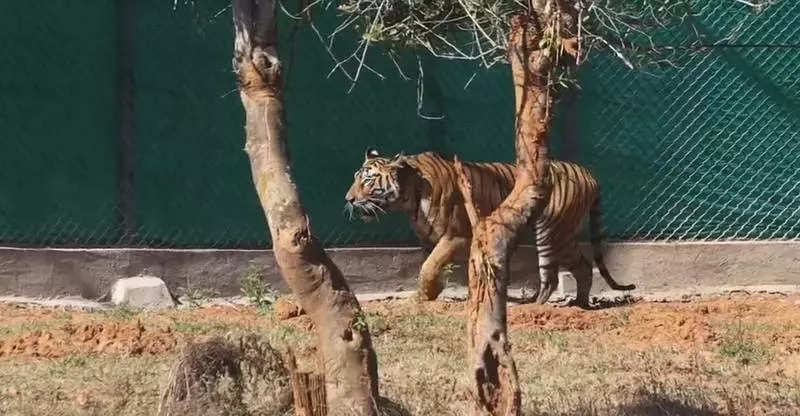Similipal takes steps to develop Zeenat’s hunting skills | Bhubaneswar News

Bhubaneswar: Similipal Tiger Reserve authorities have adopted an innovative technique to help tigress Zeenat develop natural hunting skills in her enclosure.
The ‘Boma’ method involves a sophisticated enclosure system with three compartments — the larger one for Zeenat, a passage and a prey enclosure. The prey animals are first guided into a smaller holding area through a camouflaged passage, making them feel secure and unaware of the predator’s presence. Once comfortable, they naturally move through a connecting corridor into Zeenat’s enclosure.
“The stress-free approach eliminates the need for human handling and creates a more authentic hunting scenario. The technique helps maintain Zeenat’s natural predatory instincts while ensuring that she receives adequate nutrition in a controlled environment. The enclosure has been designed in such a way that it will not give any inkling to the prey when it walks into the holding area of the tigress,” said Similipal field director Prakash Gogineni.
The new and larger enclosure, spanning eight hectares (around 20 acres), was opened to Zeenat a few days ago as she moved from the smaller one constructed in Similipal South division. The small enclosure was earlier used by tigress Yamuna. After being captured from West Bengal on Dec 29 last year, Zeenat spent close to two months in the small enclosure.
Wildlife officials said after further study of her behaviour in the larger enclosure, she may be released into the wild. In the big enclosure, her activities, including hunting skills, will be observed.
“The place where the enclosure has been set up is a prey-rich area, and the Boma technique is such that the prey, while roaming and grazing in the wild, gets into the enclosure. After the entry of two or three prey animals, we shut the outer gate and open the inner one connecting the big enclosure and the passage. Once we find that the prey has gone into the passage, we open the inner gate allowing them to move further and into Zeenat’s territory,” a wildlife official said.
The main purpose of enlarging the enclosure is to give her a feel of the forest for natural prey hunting. A larger space means the use of more hunting skills to catch prey, wildlife officials added.
On Jan 1, three-year-old Zeenat, brought from Tadoba-Andhari Tiger Reserve as part of an inter-state tiger translocation project, was released into the soft enclosure in Similipal, four days after she was darted in a forest in Bengal’s Bankura district. Zeenat returned to Similipal 24 days after she dispersed to Jharkhand and then to Bengal.
Bhubaneswar: Similipal Tiger Reserve authorities have adopted an innovative technique to help tigress Zeenat develop natural hunting skills in her enclosure.
The ‘Boma’ method involves a sophisticated enclosure system with three compartments — the larger one for Zeenat, a passage and a prey enclosure. The prey animals are first guided into a smaller holding area through a camouflaged passage, making them feel secure and unaware of the predator’s presence. Once comfortable, they naturally move through a connecting corridor into Zeenat’s enclosure.
“The stress-free approach eliminates the need for human handling and creates a more authentic hunting scenario. The technique helps maintain Zeenat’s natural predatory instincts while ensuring that she receives adequate nutrition in a controlled environment. The enclosure has been designed in such a way that it will not give any inkling to the prey when it walks into the holding area of the tigress,” said Similipal field director Prakash Gogineni.
The new and larger enclosure, spanning eight hectares (around 20 acres), was opened to Zeenat a few days ago as she moved from the smaller one constructed in Similipal South division. The small enclosure was earlier used by tigress Yamuna. After being captured from West Bengal on Dec 29 last year, Zeenat spent close to two months in the small enclosure.
Wildlife officials said after further study of her behaviour in the larger enclosure, she may be released into the wild. In the big enclosure, her activities, including hunting skills, will be observed.
“The place where the enclosure has been set up is a prey-rich area, and the Boma technique is such that the prey, while roaming and grazing in the wild, gets into the enclosure. After the entry of two or three prey animals, we shut the outer gate and open the inner one connecting the big enclosure and the passage. Once we find that the prey has gone into the passage, we open the inner gate allowing them to move further and into Zeenat’s territory,” a wildlife official said.
The main purpose of enlarging the enclosure is to give her a feel of the forest for natural prey hunting. A larger space means the use of more hunting skills to catch prey, wildlife officials added.
On Jan 1, three-year-old Zeenat, brought from Tadoba-Andhari Tiger Reserve as part of an inter-state tiger translocation project, was released into the soft enclosure in Similipal, four days after she was darted in a forest in Bengal’s Bankura district. Zeenat returned to Similipal 24 days after she dispersed to Jharkhand and then to Bengal.
The ‘Boma’ method involves a sophisticated enclosure system with three compartments — the larger one for Zeenat, a passage and a prey enclosure. The prey animals are first guided into a smaller holding area through a camouflaged passage, making them feel secure and unaware of the predator’s presence. Once comfortable, they naturally move through a connecting corridor into Zeenat’s enclosure.
“The stress-free approach eliminates the need for human handling and creates a more authentic hunting scenario. The technique helps maintain Zeenat’s natural predatory instincts while ensuring that she receives adequate nutrition in a controlled environment. The enclosure has been designed in such a way that it will not give any inkling to the prey when it walks into the holding area of the tigress,” said Similipal field director Prakash Gogineni.
The new and larger enclosure, spanning eight hectares (around 20 acres), was opened to Zeenat a few days ago as she moved from the smaller one constructed in Similipal South division. The small enclosure was earlier used by tigress Yamuna. After being captured from West Bengal on Dec 29 last year, Zeenat spent close to two months in the small enclosure.
Wildlife officials said after further study of her behaviour in the larger enclosure, she may be released into the wild. In the big enclosure, her activities, including hunting skills, will be observed.
“The place where the enclosure has been set up is a prey-rich area, and the Boma technique is such that the prey, while roaming and grazing in the wild, gets into the enclosure. After the entry of two or three prey animals, we shut the outer gate and open the inner one connecting the big enclosure and the passage. Once we find that the prey has gone into the passage, we open the inner gate allowing them to move further and into Zeenat’s territory,” a wildlife official said.
The main purpose of enlarging the enclosure is to give her a feel of the forest for natural prey hunting. A larger space means the use of more hunting skills to catch prey, wildlife officials added.
On Jan 1, three-year-old Zeenat, brought from Tadoba-Andhari Tiger Reserve as part of an inter-state tiger translocation project, was released into the soft enclosure in Similipal, four days after she was darted in a forest in Bengal’s Bankura district. Zeenat returned to Similipal 24 days after she dispersed to Jharkhand and then to Bengal.
Bhubaneswar: Similipal Tiger Reserve authorities have adopted an innovative technique to help tigress Zeenat develop natural hunting skills in her enclosure.
The ‘Boma’ method involves a sophisticated enclosure system with three compartments — the larger one for Zeenat, a passage and a prey enclosure. The prey animals are first guided into a smaller holding area through a camouflaged passage, making them feel secure and unaware of the predator’s presence. Once comfortable, they naturally move through a connecting corridor into Zeenat’s enclosure.
“The stress-free approach eliminates the need for human handling and creates a more authentic hunting scenario. The technique helps maintain Zeenat’s natural predatory instincts while ensuring that she receives adequate nutrition in a controlled environment. The enclosure has been designed in such a way that it will not give any inkling to the prey when it walks into the holding area of the tigress,” said Similipal field director Prakash Gogineni.
The new and larger enclosure, spanning eight hectares (around 20 acres), was opened to Zeenat a few days ago as she moved from the smaller one constructed in Similipal South division. The small enclosure was earlier used by tigress Yamuna. After being captured from West Bengal on Dec 29 last year, Zeenat spent close to two months in the small enclosure.
Wildlife officials said after further study of her behaviour in the larger enclosure, she may be released into the wild. In the big enclosure, her activities, including hunting skills, will be observed.
“The place where the enclosure has been set up is a prey-rich area, and the Boma technique is such that the prey, while roaming and grazing in the wild, gets into the enclosure. After the entry of two or three prey animals, we shut the outer gate and open the inner one connecting the big enclosure and the passage. Once we find that the prey has gone into the passage, we open the inner gate allowing them to move further and into Zeenat’s territory,” a wildlife official said.
The main purpose of enlarging the enclosure is to give her a feel of the forest for natural prey hunting. A larger space means the use of more hunting skills to catch prey, wildlife officials added.
On Jan 1, three-year-old Zeenat, brought from Tadoba-Andhari Tiger Reserve as part of an inter-state tiger translocation project, was released into the soft enclosure in Similipal, four days after she was darted in a forest in Bengal’s Bankura district. Zeenat returned to Similipal 24 days after she dispersed to Jharkhand and then to Bengal.
















